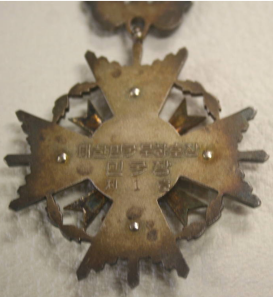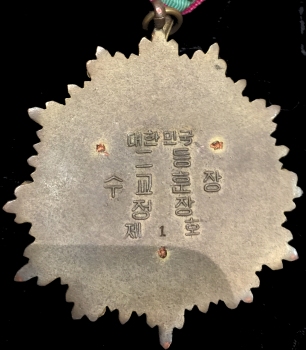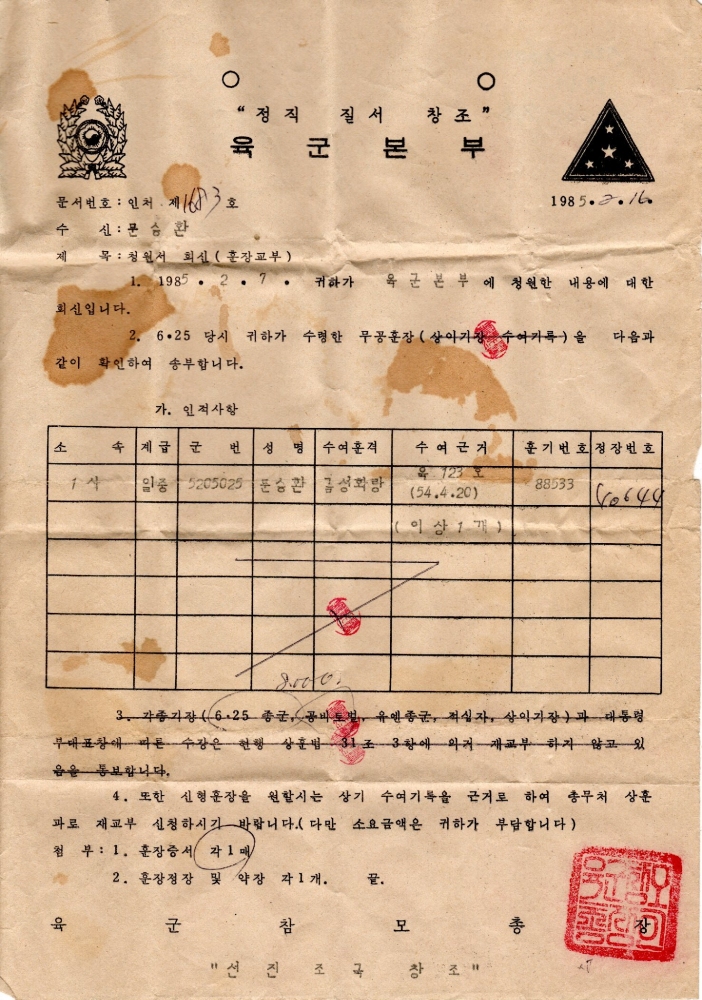Production (Serial) Numbers

On Mar. 27, 2010, someone paid an extremely high price for an Order of Cultural Merit, Republic of Korea Medal (a First Class), 1957 Series with “1” for the production number. The final price was $3,500 plus $9.95 for shipping and handling.
During the early years of the Republic of Korea, awards were recorded in handwritten logbooks. There is some indication that the number 제___호 found on the very earliest Korean Orders and Medals were used to compile lists of recipients, since the number found on the medal is duplicated on the box and on the award document, but according to the Korean Government, that system never existed. An examination of the very earliest logbook entries reveals that the numbers were generally not recorded at all. After the advent of the computer, the government assigned numbers to the handwritten logbook entries so that they could be computerized. The government can easily search their database for Korean recipients, but has a real problem when searching for a foreign name. This is primarily due to the large number of different systems that have been approved over the years and used for the transliteration of foreign names into Korean characters. There are a number of foreign sounds that cannot be accurately transliterated into Korean. For example, over the years, “L” and “R” have both been transliterated as “ㄹ”. The Korean language does not have an “F”, so the word “France” is transliterated as 프랑스 (P’u rang su). As another example: the city of Pusan is now transliterated as Busan and the city of Inchon is now transliterated as Incheon. In addition, it also depended heavily on the clerk’s ability to accurately pronounce names in a foreign language so that he could accurately transliterate the name. To give a quick indication of the transliteration problem, take a look at Gen. Robert E. Cushman in the Korean Award Database. He received 4 decorations from the Koreans and while the Robert E. (로버트이) is not an issue, his last name is listed as: “쿠시덴” Cushiden, “쿠스맨” Cuseuman, “쿠쉬맨” Cuswuiman, and “쿠시맨 Cusiman”.
In 1999, I visited Korea and was told by both the Korean Department of Orders and Medals and by the Korean Patriot’s and Veterans Affairs office, that the number on the back of any medal is useless. It cannot be used to identify the original recipient. The number on the back of any Korean Order or Medal is strictly a manufacturing control number or production number and in no way identifies the original recipient and is not traceable.
It is entirely possible for two identical medals produced under separate contracts to have the same production numbers. Likewise, It is possible that a particular medal with a high number was manufactured earlier than an identical, lower numbered medal. It all depends on what the government specified in the manufacturing contract. It has also been found that some recipients have received an order where the breast star and the pendant do not have the same production numbers. In all the examples seen so far, the numbers are different by a single digit. Take a look at the two shipping envelopes below. Over the years, a fair number of early Orders have been observed which did not have a number stamped on the reverse. Since 1984, the Korean government has completely dropped the production control numbers on the reverse.
There is another point that needs to be made. According to the Korean Medal Roll, there have been 212,504 Orders of Military Merit have been awarded over the years, so why don’t the numbers on the back of the medal reflect that. During the Vietnam War, Korean Orders of Military merit were numbered in the 10,000+ range, but not after the war. (Totals issued: 389-1st Class, 3,169-2nd Class, 20,467 3rd-Class, 173,685-4th Class, and 14,794-5th Class).1
The Ministry of Government Administration and Home Affairs (MOGAHA) is responsible for the National Archives, as well as Merits and Orders. They maintain the recipient rolls and keep strict control over their medals and decorations. For many years, the penalties were severe for anyone caught buying, selling, or misusing a Korean Medal. Early award documents to Korean Nationals are scarce. Many of these early documents, when found on the open market, have the recipient’s name blocked out. Families do not want the recipient’s name to be revealed for fear of the consequences imposed by the government. Even among Koreans, the production numbers were thought to be traceable serial numbers, so it is not uncommon to find Orders with the production number scratched out. Until the 1990s, the majority of the Korean Medals on the market were originally awarded to foreigners. It is only within recent years that Medal Collecting in Korea has become more open, although still illegal. In general, the government is purportedly going after anyone buying or selling currently issued orders, while generally leaving the trade of older designs and medals unmolested. Even that is being eroded. Current orders have been sold in public auctions, clearly visible to the government.




Order of Military Merit, Ulchi Class 을지 무공훈장
Notice that the production number for the breast star 부장 ‘3668’ is one digit lower than the number for the pendant 징장 ‘3669’.
The 재 (Jae) Hand Stamped Medals


with the hand stamp character 재.
Regarding the backplate in the image at your left. Notice the square hand stamp just in front of the production number 5917. The word within this square stamp is 재. You will have difficulty translating this word regarding a number. To give an idea of the meaning, consider 재발행 to reissue, 재방송 to resupply, 재건 reconstruction, 재군비 rearmament, 재희견 re-interview, or 재공급 to rebroadcast, etc. When used with a number, in this context, it is a shorthand prefix, meaning ‘a replacement for the original Medal’. It does not mean ‘a replacement for the original medal with the original number’. These Jae hand stamps are also found within a circle.
The document below is a confirmation letter stating that the applicant is eligible to purchase a Replacement Medal, dated Feb. 16, 1985. The backplate for the medal, that was purchased with this letter, has the 재 Jae hand stamp. You can see this in the picture to your right. The name of the recipient, his eligibility for the award, and the award date of Apr. 20, 1954, found on the document, are all confirmed in the ROK Medal Roll. Replacement medals are always done with the current design of the award and not with the same design as the originally issued award. The Order of Military Merit, Hwarang Class, that accompanied this document was a 1974 Series medal, not a 1951 Series. Also notice that the 5040 production number, found on the replacement medal, is nowhere to be found on the document. In fact, if you check my translation, it states, “Medal Number: 40644”.2
Production numbers were used to indicate the number of an award that was used to fulfill a specific unit (a specific award) within a contract. When a medal is determined to be substandard, the manufacturer is required to either repair the original or to make a new one to fulfill the contract. The 재 stamp is not the manufacturer’s way of saying that this is the replacement for an earlier, inferior piece. Of course, there are those collectors who will say that this is a replacement for a specific medal to a specific recipient, with the original specified award number, but as I said before:
“The number on the back of any Korean Order or Medal is strictly a manufacturing control number or production number and in no way identifies the original recipient and is not traceable.”

Additional note (not on the document): At the time of the original award, Mun Seung-hwan was attached to the Army Headquarters 12th Training Camp.
Translation of: Confirmation of an award and Approval to get a Replacement Medal
Emblem, upper-left corner: ROK Army
Emblem, upper-right corner: Headquarters ROK Army
Date, upper-right corner: 1985.2.16 (Feb. 16, 1985)
“Honesty Order (Law) Create” (Slogan for the Consciousness Reform Practice Movement. A government reform movement to make Korea a more democratic nation.)3
Army Headquarters4
Document number: 인처 #16835
Receipt of a message: Mun Seung-hwan (the Recipient’s Name)6
Title: Petition reply (Issuance of medal)7
1. This is my response to the petition you made to the Army Headquarters on February 7, 1985.8
2. We are confirming and sending you the military service medal you received at the time of June 25 (record of awards) as follows.9
A. Personal Information10
- Belong : 1 company11
- Grade: ?12
- Army (Serial) Number: 520502513
- Name: Mun Seung-hwan14
- Disciplinary training: Geumseong Hwarang15
- Basis for award: Army General Order #123 (Apr. 20, 1954) (More than 1 year)16
- Training number: 8853317
- Medal Number: 4064418
8,000 written in pen (If this is won it would be about $33/$34 in May 1985)
3. Lined out. Because the line runs through several vowels, I am unable to translate this part of the document.
4. Also, if you wish to receive a new medal, please apply for re-issuance to the Awards and Medals Division of the Ministry of General Affairs based on the award records above. (However, you are responsible for the cost)19
Attachment:20
Footnotes:
- Aug. 15, 1948 through Sept. 30, 2023
- 정장번호: 40644
- “정직 질서 창조”
- 육군본부
- 문서번호: 인처 제1683호
- 수신: 문승환
- 제목: 청원서 회신 (훈장교부)
- 1985.2.7 귀하가 욕군본부 에 청원한 내용에 대한희신입니다1.
- 6.25 당시 귀하가 수령한 무공훈장 (
상이기장 수여기륵)을 다음과같이 확인하여 송부합니다. - 가.인적사항 (가, 나, 다…is the Korean equivalent to A, B, C…)
- 소속 : 1사
- 졔급: 일중
- 군번: 5205025
- 성명: 문승환
- 수여훈격: 금성화랑
- 수여근거: 육123호 (54.4.20)(이상1래)
- 훈기번호: 88533
- 정장번호: 40644
- 4. 또한 신형훈장을 원할시는 상기 수여기록을 근거로 하여 총무처 상훈과로 재교부 신청하시기 바럽니다. (다만 소요금액은 귀하가 부담함니다)
- 첨부:
- 1. 훈장증서 각1매1.
- 2. 훈장정장 및 약장 각1개. 끝.
- 육군참모총장
- “정직 질서 창조”
